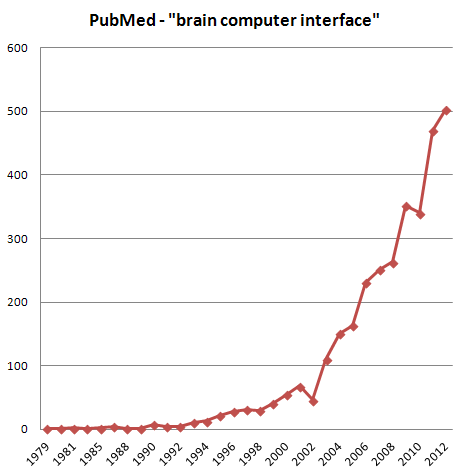It is important to realize that the fashion in any technology business is necessary for an acceleration potential, e.g. more money for R&D. Still fashionability has nothing to do with the technology itself. You can have least developed, expensive, compexity-redundant but for some reason well-known (marketed) solution.

From the technological perspective we did a big moves in the field of Brain-Computer Interfaces. I propose here to look carefully at the graph (above) and a chronology of main results in the domain(below) to analyze correlation of article number and results.
- 1957: John Eccles used intracellular single-unit recording to study synaptic mechanisms in motoneurons (for which he won the Nobel Prize in 1963).
- 1958: Stainless steel microelectrodes developed for recording.
- 1959: Studies by David H. Hubel and Torsten Wiesel. They used single neuron recordings to map the visual cortex in unanesthesized, unrestrained cats using tungsten electrodes. This work won them the Nobel Prize in 1981 for information processing in the visual system.
- 1960: Glass-insulated platinum microelectrodes developed for recording.
- 1967: The first record of multi-electrode arrays for recording was published by Marg and Adams. They applied this method to record many units at a single time in a single patient for diagnostic and therapeutic brain surgery.
- 1978: Schmidt et al. implanted chronic recording micro-cortical electrodes into the cortex of monkeys and showed that they could teach them to control neuronal firing rates, a key step to the possibility of recording neuronal signals and using them for BMIs.
- 1981: Kruger and Bach assemble 30 individual microelectrodes in a 5×6 configuration and implant the electrodes for simultaneous recording of multiple units.
- 1992: Development of the “Utah Intracortical Electrode Array (UIEA), a multiple-electrode array which can access the columnar structure of the cerebral cortex for neurophysiological or neuroprosthetic applications”.
- 1994: The Michigan array, a silicon planar electrode with multiple recording sites, was developed. NeuroNexus, a private neurotechnology company, is formed based on this technology.
- 1998: A key breakthrough for BMIs was achieved by Kennedy and Bakay with development of neurotrophic electrodes. In patients with amyotrophic lateral sclerosis (ALS), a neurological condition affecting the ability to control voluntary movement, they were able to successfully record action potentials using microelectrode arrays to control a computer cursor.
As you can probably see, there is no correlation. The last 15 years are the years of steady incremental innovation. BCI is becoming more popular, But… Bit these indirect data give us a sign that the field is still in the phase of early development. Present limitations are due to lack of knowledge of the neuronal signalling mechanisms that lay beneath electrical activation or technical methods of signal processing.



